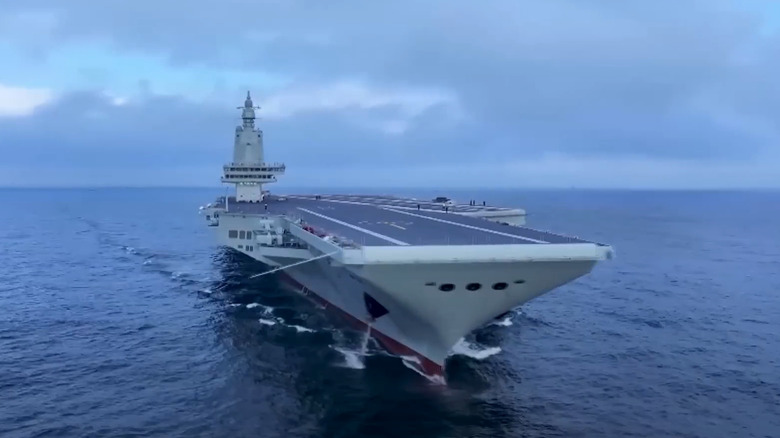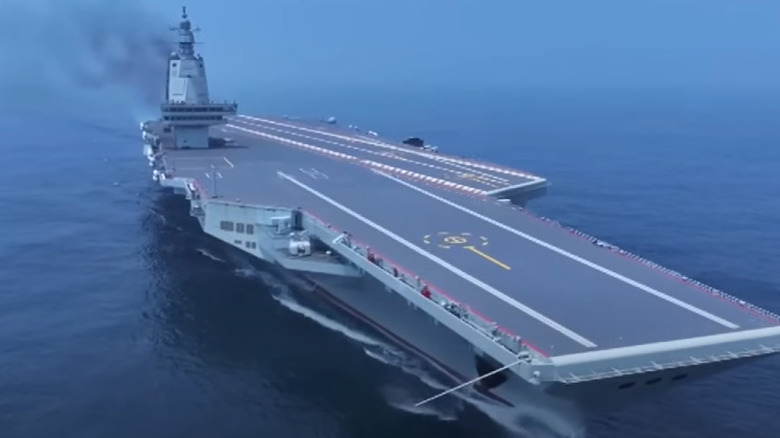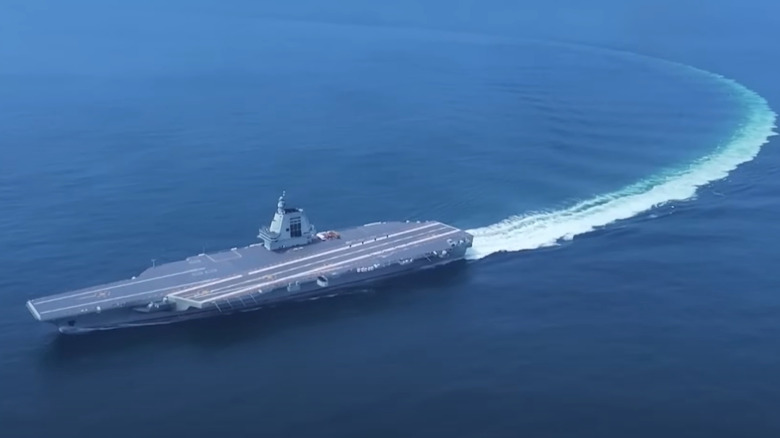Everything We Know About China's 'Unsinkable' Fujian Aircraft Carrier
The world's largest navy is about to get a serious upgrade — and it doesn't mind showing it off. Over the past two decades, China has invested heavily in expanding its People's Liberation Army Navy (PLAN), a key strategy for cementing its position in the coastal waters of the Indo-Pacific. Adding nearly 200 warships since 2000, the Chinese navy has grown from a geopolitical afterthought to a force capable of projecting global ambitions. One critical development is China's expanding aircraft carrier fleet, which looks to add its third carrier, the 80,000-ton Fujian. With reports of its construction first released in March 2017, the long-discussed Fujian is the PRC's largest and most advanced carrier yet. Currently executing sea trials in the contested waters of the Yellow Sea, the ship is expected to be operational by the end of 2025 — a major step in the country's regional and global ambitions.
Sporting China's first electromagnetic aircraft launch system, deploying the Fujian will be a major boon for China's aerial forces, greatly expanding the mission set of its J-15 and J-35 fighter jets. It is also notable for how it compares with China's previous two carriers, the Liaoning and Shandong. Larger and better equipped than either of its predecessors, the Fujian represents both a major leap in the Chinese Navy's carrier fleet and an escalation of its global power projection capabilities, potentially extending its naval reach beyond the Indo-Pacific.
The Fujian aircraft carrier at a glance
At an estimated 1,036 feet long and 80,000 tons, the Fujian is roughly 15,000 tons larger than its two predecessors. In fact, the steam turbine–powered colossus is the largest non-nuclear ship in the world, standing only behind America's two nuclear-powered carriers in total tonnage. With this size, the Fujian can likely carry up to 60 aircraft and is expected to launch fixed-wing and rotary-wing aircraft, ranging from China's infamous J-15 and J-35 fighters to the KJ-600 airborne early warning aircraft. This would be a major improvement over the PLAN's Liaoning and Shandong carriers, which can only handle ramp-assisted short take-off aircraft.
This variety is enabled by China's first electromagnetic aircraft launch system. Outside of the USS Gerald R. Ford, the Fujian is the only ship known to operate such a system. In addition to supporting a greater variety of aircraft, the electromagnetic system is purported to launch aircraft at a faster rate than its predecessors, meaning it could be China's first carrier with "deck load strike" capability. Colloquially known as swarm attacks, "deck load strike" refers to when an aircraft carrier can launch a large number of aircraft in a single strike.
According to Chinese state broadcaster CCTV, the Fujian can execute Alpha strikes, a type of deck strike made up of different aircraft types, like fighter jets and helicopters. This in turn would upgrade China's first-mover capabilities, referring to an aircraft carrier's ability to launch a decisive strike in the initial wave of combat, and would greatly expand the PLA Air Force's force projection toolkit. While little is known about the carriers' arsenal, satellite images show the Fujian rocking at least four close-in weapons and four missile point defense systems — similar to the U.S. Navy's SeaRAM defense system which is deployed on U.S. carriers.
The Chinese navy's large ambitions
As part of China's rapid naval buildup, the Fujian is the next step in the PLAN's quest to become a global naval power. Despite deploying the world's most warships, China has historically focused on the Indo-Pacific, with most of its fleet consisting of smaller ships designed to operate within the coastal waters of the South China Sea. Recently, however, China has steadily added ships that support longer-distance operations. In addition to building three aircraft carriers since 2012, the PLAN has doubled its destroyers and added eight Renhai-class cruisers, all while ushering in a new set of logistical support ships built specifically to facilitate long-term deployments, including the new Fuyu fast combat support ship and the Dakai- and Dafeng-class submarine support ships.
However, the Fujian represents more than a jump in capability. As geopolitical expert Malcom Davis told the South China Morning Post, it gives China valuable experience operating complex "big deck" carriers. Considering the learning curve for large deck carriers like the USS Gerald R. Ford, the Fujian will prove invaluable for the PRC as it constructs its fourth carrier: a nuclear-powered supercarrier.
These advancements support China's increasingly ambitious naval deployments. According to a 2024 Department of Defense report, China has steadily extended its naval operations beyond its typical patrols in the South China Sea. The most recent forays came in May and June 2025, when China's two active carriers executed exercises near U.S. strategic points in Okinawa, Taiwan, and Guam — a clear signal of China's desire to project aerial and naval prowess in the region. The Fujian, for its part, completed its eighth round of trials in May 2025 and looks to enter service by the end of the year.


